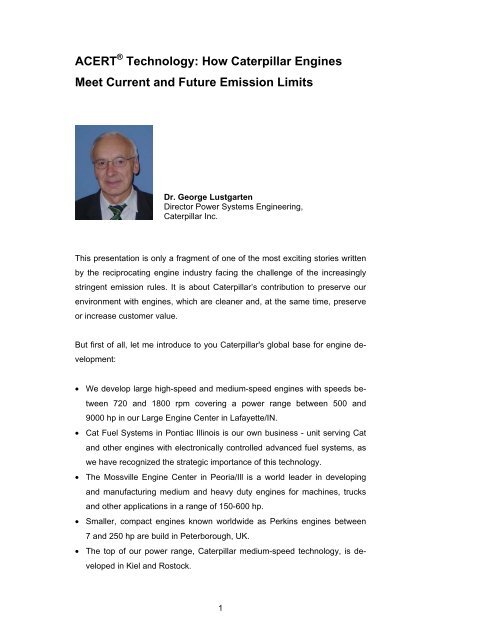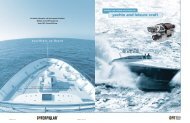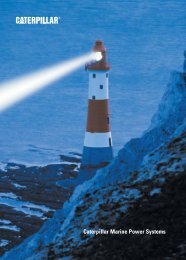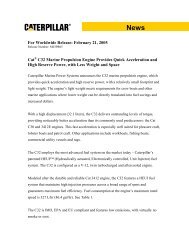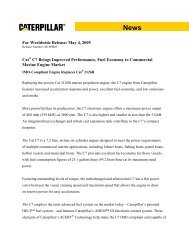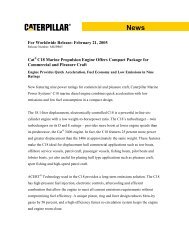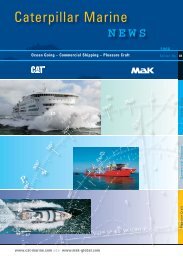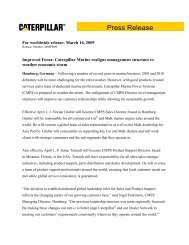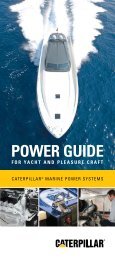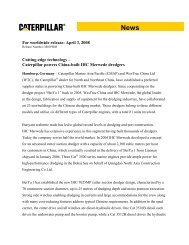ACERT Technology: How Caterpillar Engines Meet Current and ...
ACERT Technology: How Caterpillar Engines Meet Current and ...
ACERT Technology: How Caterpillar Engines Meet Current and ...
Create successful ePaper yourself
Turn your PDF publications into a flip-book with our unique Google optimized e-Paper software.
<strong>ACERT</strong> ® <strong>Technology</strong>: <strong>How</strong> <strong>Caterpillar</strong> <strong>Engines</strong><br />
<strong>Meet</strong> <strong>Current</strong> <strong>and</strong> Future Emission Limits<br />
Dr. George Lustgarten<br />
Director Power Systems Engineering,<br />
<strong>Caterpillar</strong> Inc.<br />
This presentation is only a fragment of one of the most exciting stories written<br />
by the reciprocating engine industry facing the challenge of the increasingly<br />
stringent emission rules. It is about <strong>Caterpillar</strong>’s contribution to preserve our<br />
environment with engines, which are cleaner <strong>and</strong>, at the same time, preserve<br />
or increase customer value.<br />
But first of all, let me introduce to you <strong>Caterpillar</strong>'s global base for engine development:<br />
• We develop large high-speed <strong>and</strong> medium-speed engines with speeds between<br />
720 <strong>and</strong> 1800 rpm covering a power range between 500 <strong>and</strong><br />
9000 hp in our Large Engine Center in Lafayette/IN.<br />
• Cat Fuel Systems in Pontiac Illinois is our own business - unit serving Cat<br />
<strong>and</strong> other engines with electronically controlled advanced fuel systems, as<br />
we have recognized the strategic importance of this technology.<br />
• The Mossville Engine Center in Peoria/Ill is a world leader in developing<br />
<strong>and</strong> manufacturing medium <strong>and</strong> heavy duty engines for machines, trucks<br />
<strong>and</strong> other applications in a range of 150-600 hp.<br />
• Smaller, compact engines known worldwide as Perkins engines between<br />
7 <strong>and</strong> 250 hp are build in Peterborough, UK.<br />
• The top of our power range, <strong>Caterpillar</strong> medium-speed technology, is developed<br />
in Kiel <strong>and</strong> Rostock.<br />
1
The global Research & Development (R&D) activity is supported by our Technical<br />
Research Center located at <strong>Caterpillar</strong>’s headquarters in Peoria/Ill. It<br />
supports our engineers with fundamental research on combustion, emissions,<br />
noise, structures, advanced materials <strong>and</strong> complete power systems. <strong>Engines</strong><br />
are tested in over 100 cells capable to accommodate units up to 9000 hp.<br />
Emissions have been the primary driver of engine development during the last<br />
decade, as shown here for the Environmental Protection Agency (EPA) NOx<br />
limits. The most restrictive on-highway limits precede only by 2 - 4 years the<br />
l<strong>and</strong> based application. NOx <strong>and</strong> particulate emissions have been dramatically<br />
reduced <strong>and</strong> will be reduced by an additional 95 % until 2010. Eventually all<br />
emissions will converge towards a “Near Zero Emission” situation.<br />
Marine emission rules are lagging behind but show a downward trend as well.<br />
They will leverage the technology developed for the on-highway application.<br />
The pressure is increasing, not only from the regulator side who even offers<br />
incentives for low emissions but also from the users <strong>and</strong> shipbuilder side.<br />
They are ready to accept their environmental responsibility, want to preserve<br />
the value of their investment <strong>and</strong> favor low NOx solutions, “Green Ships” <strong>and</strong><br />
invisible smoke.<br />
The diesel industry has responded to the challenge <strong>and</strong> established a record<br />
of continuous improvement in customer value while making our engines<br />
cleaner.<br />
As emission limits become more stringent, solving the value equation becomes<br />
more difficult:<br />
Emission reduction with conventional methods may reduce customer value,<br />
affecting fuel efficiency, requiring complex systems, expensive aftertreatment<br />
installations, addition of water, etc.<br />
We, at <strong>Caterpillar</strong>, have accepted the challenge to reduce emissions but increase<br />
customer value at the same time.<br />
2
In 1999, <strong>Caterpillar</strong> started to fund R&D work for what would become the largest<br />
single effort in this industry, with the following objectives:<br />
• <strong>Meet</strong> the most stringent current emission rules<br />
• Enhance true customer value<br />
• Minimize pollutants where they are generated, i.e. in the combustion space<br />
• We have also developed a technology, which serves as a stepping-stone<br />
for meeting future regulations applying evolutionary steps.<br />
<strong>Caterpillar</strong> has spent in this effort some $750M, <strong>and</strong> continues to spend until<br />
“Near Zero Emissions” come true. Therefore, we have decided to leverage this<br />
huge investment across the whole engine range, starting with the high-speed<br />
engines used for on-highway <strong>and</strong> l<strong>and</strong> based applications up to the mediumspeed<br />
engines produced in Kiel <strong>and</strong> Rostock.<br />
The result is what we call the <strong>ACERT</strong> ® <strong>Technology</strong>, a unique solution for emission<br />
reduction.<br />
It has already been successfully introduced for high-speed, heavy duty all the<br />
way up to some 1700 hp. What makes the difference?<br />
It is the superior system integration of key technologies:<br />
• A hydraulically actuated, fully flexible fuel system, capable of split injections,<br />
variable timing <strong>and</strong> able to flex in injection intensity <strong>and</strong> fuel rate.<br />
• A high boost, single- or two-stage, very compact turbocharger arrangement<br />
to reduce the combustion temperatures by increasing the amount of air.<br />
• Flexible, electronically controlled valve timing combining Turbo Power with<br />
Intelligent Valve Control optimizing fuel efficiency <strong>and</strong> emission for each<br />
operation point.<br />
• A low emission combustion system with intensive mixing for rapid combustion.<br />
• As the flexibility of the system is increased, a huge number of parameters<br />
can be now selected to change the characteristics of Fuel Systems <strong>and</strong> Air<br />
Systems. Powerful <strong>Caterpillar</strong> electronic controls do the job.<br />
• Finally, simple <strong>and</strong> reliable oxidation catalysts are used only as an exception<br />
to finish the good combustion job done by the engine itself.<br />
3
The principles applied here are similar for the medium-speed engines as you<br />
will see later on.<br />
The production of emission certified <strong>ACERT</strong> ® engines was started more than a<br />
year ago. We have successfully met the stringent emission rules for mobile<br />
<strong>and</strong> stationary applications. We have certified our product for the newly enforced<br />
EPA emission rules (equivalent to Euro 4). We have also demonstrated<br />
that the <strong>ACERT</strong> ® <strong>Technology</strong> is more reliable, less complex <strong>and</strong> more efficient<br />
than the rest of the industry.<br />
The huge investment made with <strong>ACERT</strong> ® is currently leveraged across the<br />
whole <strong>Caterpillar</strong> product base:<br />
• It is exp<strong>and</strong>ed at the lower end in the 100-250 hp range for the Perkins engines.<br />
It is also applied for our large high-speed product up to some<br />
5400 hp, which is going to set new st<strong>and</strong>ards in efficiency, power density<br />
<strong>and</strong> reliability for marine <strong>and</strong> other l<strong>and</strong> based applications.<br />
And finally we have initiated the introduction of the <strong>ACERT</strong> ® <strong>Technology</strong> to our<br />
medium-speed product for marine use, subject of today's presentation.<br />
Key criteria applied were:<br />
• Use the same synergistic system approach, instead of forcing a quantum<br />
step in the development of a single technology.<br />
• Combine the traditional MaK engine reliability <strong>and</strong> vast experience in HFO<br />
operation with the best <strong>and</strong> finest of <strong>Caterpillar</strong> engine technology.<br />
• Avoid additional cost <strong>and</strong> complexity of complicated systems such as aftertreatment<br />
or water injection. Let the engine itself do the job to the maximum<br />
possible extent!<br />
4
We have defined our first <strong>and</strong> immediate goal in migrating of the <strong>ACERT</strong> ®<br />
emission technology to the MaK engine as follows:<br />
• Demonstrate NOx levels 30 % below the current IMO rules with advanced,<br />
<strong>ACERT</strong> ® combustion technology without any external systems or complex<br />
additions to the engine design but maintain the excellent fuel efficiency, a<br />
distinguishing feature of the MaK engine.<br />
• Achieve invisible smoke over the whole operation range, particularly important<br />
for passenger ships <strong>and</strong> frequent operation in emission sensitive areas<br />
such as coastal waters.<br />
You will recognize that the key elements of medium-speed <strong>ACERT</strong> ® <strong>Technology</strong><br />
are very similar to their high-speed counterpart.<br />
Superior integration continues to be the main differentiator. It combines key<br />
technologies such as combustion, fuel injection, turbocharging, <strong>and</strong> valve control.<br />
Our endeavor was, to quickly leverage the <strong>ACERT</strong> ® specific flexibility in the<br />
rugged marine environment by using readily available, simple, proven <strong>and</strong><br />
reliable components. The enabler is called the Flex Cam <strong>Technology</strong>.<br />
But let us highlight the key features in more detail:<br />
1. The starting point: The combustion system benefits from the long-stroke<br />
technology, the foundation for clean combustion <strong>and</strong> high fuel efficiency,<br />
distinguishing feature of the MaK engine against the rest of the industry.<br />
2. The variable injection intensity is key for good combustion <strong>and</strong> invisible<br />
smoke at low load. It improves atomization <strong>and</strong> fuel distribution. The injection<br />
characteristic is modified at low load by the simple <strong>and</strong> reliable eccentric<br />
cam mechanism - the Flex Cam. As our engines are designed to burn<br />
heavy fuels of lowest quality, we have decided to maintain - for the time being<br />
- the robust mechanical injection, capable to deliver fuel at pressures<br />
beyond 1600 bar. Hydraulically actuated fuel systems with equivalent capability<br />
are under development <strong>and</strong> will be applied in a next step, as you<br />
will hear later on.<br />
5
3. High performance turbochargers interact with the load controlled, variable<br />
valve timing system. This is a key enabler for low NOx emissions <strong>and</strong> rapid<br />
engine acceleration characteristic. Again, the Flex Cam mechanism is<br />
adapting valve opening <strong>and</strong> closing events over the engine load.<br />
The Flex Cam control system consists, as already mentioned, of simple, rugged<br />
components, easily adaptable to the st<strong>and</strong>ard engine. The pneumatically<br />
actuated eccentric mechanism controls position between roller <strong>and</strong> fuel-, respectively<br />
valve cams. A complete retrofit kit including the Flex Cam module,<br />
fuel system <strong>and</strong> turbocharger components can be easily applied for engines<br />
already in operation.<br />
The first engine to benefit from the <strong>ACERT</strong> ® <strong>Technology</strong> is the M 43, as it offers<br />
an attractive solution for emission sensitive applications such as ferries,<br />
cruise ships, RoRo’s.<br />
Goal achievement has been fully demonstrated:<br />
• NOx emissions amount to 8 g/kWh <strong>and</strong> below, all the way down to 25 %<br />
engine load, which is 30 % less than the current emission st<strong>and</strong>ard.<br />
• Smoke remains below the visibility limit of 0,5 over the whole operation<br />
range. Optionally, smoke can be reduced to less than 0,3 for engines meeting<br />
the IMO NOx st<strong>and</strong>ards only.<br />
Production for the <strong>ACERT</strong> ® technology has been officially released for the<br />
M 43 C. The same feature is currently being introduced to the M 32 C.<br />
As previously emphasized, we, at <strong>Caterpillar</strong>, aim to stay in the front league in<br />
meeting the future emission regulations. First engine tests on MaK engines,<br />
with exp<strong>and</strong>ed <strong>ACERT</strong> ® <strong>Technology</strong>, have revealed additional opportunities.<br />
We have already run the engine with hydraulically controlled fuel systems capable<br />
of split injections. We have demonstrated that <strong>ACERT</strong> ® multi-parameter<br />
optimization techniques are able to reduce NOx emission by 50 % <strong>and</strong> run the<br />
engine without any visible smoke, which is the target area for our next development<br />
step.<br />
6
We detain a large experience with electronically controlled, hydraulically actuated<br />
advanced fuel systems used in small, medium <strong>and</strong> large high-speed engines.<br />
This constitutes the solid platform from which <strong>Caterpillar</strong> plans to launch<br />
unique fuel system designs, capable to meet the expectation of our customers<br />
in heavy fuel operation.<br />
The launch of an extensive field testing <strong>and</strong> validation program with what we<br />
call the Single Fluid Hydraulically Controlled Fuel System is already underway.<br />
I am reaching the conclusion:<br />
The application of <strong>ACERT</strong> ® <strong>Technology</strong> across the whole <strong>Caterpillar</strong> engine<br />
base has offered a unique opportunity to strengthen the position of the reciprocating<br />
engine, a technology invented more than 100 years ago. Power density<br />
has demonstrated quantum steps without affecting reliability. Efficiency is unparalleled.<br />
All this happened under the pressure of economics.<br />
Superior system integration, or what we have defined as <strong>ACERT</strong> ® <strong>Technology</strong><br />
adds a new dimension. It has resolved the complicated balance between superior<br />
customer value <strong>and</strong> low emissions.<br />
It has made <strong>Caterpillar</strong> marine medium-speed engines ready to accept the<br />
current <strong>and</strong> future challenge of emission st<strong>and</strong>ards without or with little additional<br />
complexity. Which is, so we do believe, in the best interest of our customers<br />
in the marine industry.<br />
7
Cat Fuel Systems<br />
Pontiac Ill<br />
Large Engine Center<br />
Lafayette IN<br />
500-9000 hp<br />
<strong>Caterpillar</strong> Confidential: green<br />
<strong>Caterpillar</strong> Inc.<br />
Global Base for Engine Development<br />
Med. & Heavy Duty<br />
High-Speed<br />
Peoria, Ill<br />
Greenville NC<br />
150-600 hp<br />
Compact <strong>Engines</strong><br />
Peterborough, UK<br />
7-250 hp<br />
Medium-Speed<br />
Kiel & Rostock, D<br />
1000-22000 hp
<strong>Caterpillar</strong> Confidential: green<br />
<strong>Caterpillar</strong> Inc.<br />
Emission Rules: The Main <strong>Technology</strong> Driver<br />
N0 x (g/hp*hr)<br />
12<br />
10<br />
8<br />
6<br />
4<br />
2<br />
0<br />
IMO I<br />
IMO II<br />
1980 1985 1990 1995 2000 2005 2010 2015
Customer Value<br />
<strong>Caterpillar</strong> Confidential: green<br />
<strong>Caterpillar</strong> Inc.<br />
The Challenge<br />
Customer<br />
Expectations<br />
We must<br />
maintain<br />
customer value<br />
Emissions<br />
Future<br />
regulations<br />
challenge the<br />
value equation<br />
History
Flexible Fuel Systems<br />
<strong>Caterpillar</strong> Confidential: green<br />
<strong>Caterpillar</strong> Inc.<br />
Superior System Integration<br />
<strong>ACERT</strong> ® <strong>Technology</strong> for Heavy Duty <strong>Engines</strong><br />
Combustion<br />
Controls<br />
Aftertreatment<br />
Advanced Turbocharging<br />
Variable Valve<br />
Timing
Leveraging <strong>ACERT</strong> ® <strong>Technology</strong> to Marine <strong>Engines</strong><br />
<strong>Caterpillar</strong> Confidential: green<br />
<strong>Caterpillar</strong> Inc.<br />
� Use the <strong>ACERT</strong> ® System Approach<br />
� Maintain MaK Engine Reliability in Heavy Fuel Operation<br />
� Avoid Additional Cost Complexity of Aftertreatment Systems<br />
(SCR, Water Injection,..)
Smoke Emission (FSN)<br />
2<br />
1.5<br />
1<br />
0.5<br />
0<br />
<strong>Caterpillar</strong> Confidential: green<br />
<strong>Caterpillar</strong> Inc.<br />
Achieve invisible<br />
smoke over the<br />
whole operation<br />
range<br />
<strong>ACERT</strong> ® Goal<br />
<strong>Meet</strong>ing Customer Expectations <strong>and</strong> Future Emission Rules<br />
0 20 40 60 80 100<br />
Power Output (%)<br />
Reduce NO x to meet<br />
local regulations <strong>and</strong><br />
future IMO rules<br />
-30%<br />
20<br />
15<br />
10<br />
5<br />
0<br />
NOx Emission (g/kWh)
<strong>Caterpillar</strong> Confidential: green<br />
<strong>Caterpillar</strong> Inc.<br />
<strong>ACERT</strong> ® Making a Difference<br />
Superior System Integration with Flex Cam<br />
<strong>Technology</strong><br />
Long Stroke<br />
<strong>Technology</strong><br />
Variable Injection<br />
Intensity<br />
FCT Control<br />
The Medium<br />
Speed <strong>ACERT</strong><br />
SCR only Optional<br />
High Performance<br />
Turbo<br />
Variable Valve<br />
Timing
<strong>Caterpillar</strong> Confidential: green<br />
<strong>Caterpillar</strong> Inc.<br />
The Starting Point for <strong>ACERT</strong> ®<br />
The MaK Engine is built upon the Long-Stroke <strong>Technology</strong><br />
Stoke / Bore Ratio (-)<br />
1,8<br />
1,6<br />
1,4<br />
1,2<br />
1,0<br />
M 20 M 25 M 32<br />
M 43<br />
MaK<br />
Others<br />
150 250 350 450 550<br />
Bore (mm)<br />
MaK engines have a long stroke<br />
design which is leading the field
Introducing <strong>ACERT</strong> ® Fuel System Flexibility<br />
for Medium-Speed <strong>Engines</strong> running on HFO<br />
Requirements for<br />
Low Smoke<br />
Emission:<br />
� High Injection<br />
Pressure Capability<br />
(> 1600 bar)<br />
� High Injection<br />
Intensity at Low<br />
Load<br />
<strong>Caterpillar</strong> Confidential: green<br />
<strong>Caterpillar</strong> Inc.
Introducing <strong>ACERT</strong> ® <strong>Technology</strong> to Air Systems<br />
for Medium-Speed <strong>Engines</strong>, running on HFO<br />
<strong>Caterpillar</strong> Confidential: green<br />
<strong>Caterpillar</strong> Inc.<br />
Variable inlet valve event for NO x Reduction<br />
Variable exhaust valve event for better load pick up
<strong>Caterpillar</strong> Confidential: green<br />
<strong>Caterpillar</strong> Inc.<br />
<strong>ACERT</strong> ®<br />
The Elements of the FCT System
Smoke- Emission (FSN)<br />
2,5<br />
2,0<br />
1,5<br />
1,0<br />
0,5<br />
0,0<br />
<strong>Caterpillar</strong> Confidential: green<br />
<strong>Caterpillar</strong> Inc.<br />
<strong>ACERT</strong> ® For M 43 C<br />
Smokeless Operation with reduced NO x Emissions<br />
Switch Point<br />
0 25 50 75 100<br />
Power Output (%)<br />
Smoke<br />
NO x<br />
15<br />
12<br />
9<br />
6<br />
3<br />
0<br />
NOx - Emission (g/kWh)
max. Smoke Emission (FSN)<br />
<strong>Caterpillar</strong> Confidential: green<br />
<strong>Caterpillar</strong> Inc.<br />
2<br />
1,5<br />
1<br />
0,5<br />
0<br />
Invisible Smoke<br />
<strong>ACERT</strong> ® Roadmap<br />
Prepared to <strong>Meet</strong> Future Emission Regulations<br />
SFH<br />
Step 2<br />
Target Area<br />
IMO II<br />
Low NOx<br />
0 2 4 6 8 10 12 14<br />
NOx Emission Cycle Value (g/kWh)<br />
FCT<br />
IMO I<br />
Low Smoke<br />
IMO
<strong>Caterpillar</strong> Confidential: green<br />
<strong>Caterpillar</strong> Inc.<br />
The new VM 43 C <strong>ACERT</strong>® with<br />
� Smokeless operation<br />
Flex Cam <strong>Technology</strong><br />
� Ready for IMO II NO x Emission St<strong>and</strong>ards<br />
� Proven <strong>Technology</strong><br />
� Lowest Complexity<br />
� Retrofit Capability


